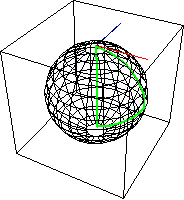
On a Riemannian manifold , tangent vectors can be moved along a path by parallel
transport, which preserves vector addition
and scalar multiplication. So a closed loop
at a base point
,
gives rise to a invertible linear map of
, the tangent vectors at
. It is possible to compose closed loops by following one after
the other, and to invert them by going backwards. Hence, the set of linear transformations
arising from parallel transport along closed
loops is a group, called the holonomy group.
Since parallel transport preserves the Riemannian metric, the holonomy group is contained in the orthogonal
group .
Moreover, if the manifold is orientable, then
it is contained in the special orthogonal
group. A generic Riemannian metric on an
orientable manifold has holonomy group
, but for some special metrics it
can be a subgroup, in which case the manifold is said to have special holonomy.
A Kähler manifold is a -dimensional manifold whose holonomy
lies in the unitary group
. A Calabi-Yau manifold is a simply
connected
-dimensional
manifold with holonomy in the special unitary
group. A
-dimensional
manifold with holonomy group
, the quaternionic unitary group, is called a hyper-Kähler
manifold, and one with holonomy
is called a quaternion
Kähler manifold. The possible groups that can arise as a holonomy group
of the metric compatible Levi-Civita connection
were classified by Berger. The other possibilities for a nonproduct, nonsymmetric
manifold are the Lie groups
and
. (Note that while Berger (1955) listed
as a possibility of a Riemannian nonsymmetric, holonomy
group, this possibility was excluded by Gray and Brown (1972).)
On a flat manifold, two homotopic loops give the same linear transformation. Consequently, the holonomy group is a group
representation of the fundamental group
of .
In general though, the curvature of
changes the parallel transport
between homotopic loops. In fact, there is a formula for the difference as an integral
of the curvature.